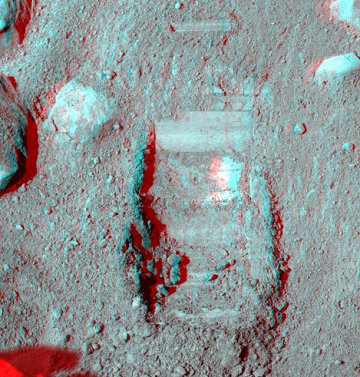| FLYBY ALERT! Space shuttle Discovery launched on May 31st. Get your flyby alerts from Space Weather PHONE | | | MOON SHOW: When the sun sets tonight, go outside and look west. Saturn, Mars and the slender crescent Moon are making a pretty line across the sky. Consider it a prelude to an even better show this weekend featuring a Mars-Moon conjunction on Saturday and a tight celestial triangle on Sunday. Let the Moon be your guide: June 6th, 7th, 8th. images: from Mahdi Rahimi of Isfahan, Iran; from Mohammad Soltanolkottabi of Esfahan, Iran; from Elias Chasiotis of Athens, Greece; from P-M Hedén of Vallentuna, Sweden; from Niloofar Khavari of Dehkade, Karaj, Iran; from Miguel Claro of Almada, Portugal SCOOP TWO: Phoenix's robotic arm has taken its second scoop out of Mars. The resulting trench reveals a splash of mysterious white material just below the topsoil. Put on your 3D glasses for an in-depth look: 
Graphic artist Patrick Vantuyne of Belgium created the anaglyph by combining right- and left-eye images from Phoenix's stereo camera. Staring for a while improves the 3D effect; indeed, the full-sized anaglyph may make you feel as if you're about to fall in. Don't worry, the actual trench is only 1.5-inches deep. The white substance in the trench is an unknown. It could be ice, salt, or something else entirely. Researchers may have found a clue in images from Phoenix's onboard microscope. This week, the microscope got its first look at specks of dust and soil, and there was a translucent particle shining relatively white against the ambient red. Researchers say it looks like a grain of salt, but they can't be sure. The final answer won't be known until Phoenix tips a sample into the lander's mass spectrometer. Stay tuned for chemical analysis! LONG DISTANCE SPACE STATION: The International Space Station (ISS) has grown so big and bright that on June 3rd when the sprawling spacecraft flew over southern France, amateur astronomer Ralf Vandebergh was able to photograph it from the Netherlands. "Normally, I would never try to photograph the ISS so close to the horizon (34o elevation), but there was an important spacewalk going on and I really wanted to capture the scene." 
Vandebergh tracked the ISS by hand, manually guiding his 10-inch telescope while a digital video camera recorded the view through the eyepiece. "In the animation, keep an eye on the space shuttle Discovery and you may be surprised how much detail you can see," he says. Not visible in the animation are the ant-like figures of spacewalking astronauts busily working to install a new bus-sized module (Japan's Kibo science lab) delivered the previous day in the cargo hold of the space shuttle. The installation was a success and now the ISS is even bigger and brighter than before. This weekend the ISS is making a series of lovely flybys over the Americas. Please try our Simple Flybys tool to find out when to look. more images: from Dan Earl of Grass Valley, Oregon; from Bryan of Babylon, New York; from Steve Newcomb of Oakland, Maryland; from Paco Bellido of Córdoba, Spain;
May 2008 Aurora Gallery
[Aurora Alerts] [Night-sky Cameras] | 
